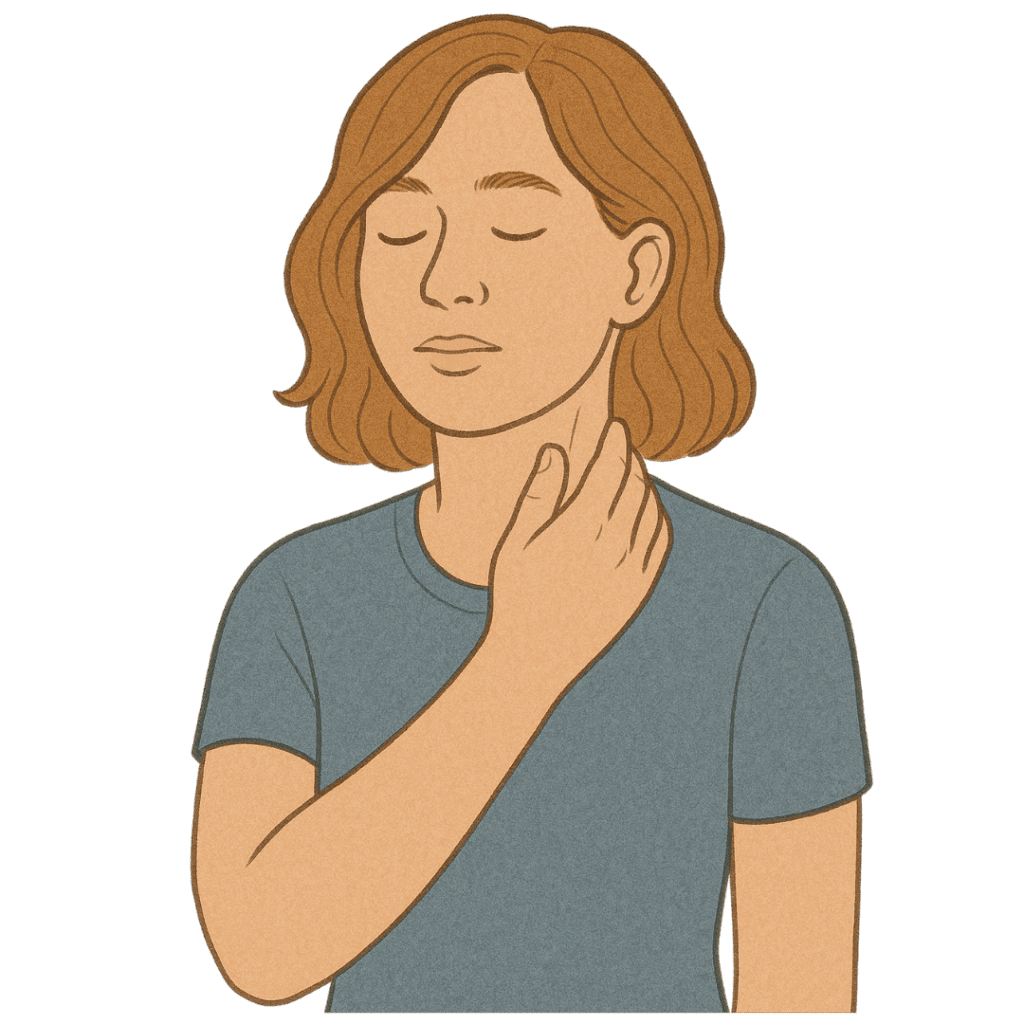6 Ways to Stop a Panic Attack (That Actually Work With Your Nervous System)
If you’ve ever experienced a panic attack, you know how terrifying they can be. Your heart races, your breathing becomes shallow, and you might even feel like you’re having a heart attack or dying. The experience is so overwhelming that many people end up in the emergency room, only to be told: “It’s just anxiety.”
But panic attacks are far more than “just” anxiety. They happen when the threat load on your nervous system tips past capacity. And once you understand what’s happening inside your body, you can start to work with it instead of against it.
What Is a Panic Attack (Through a Nervous System Lens)?
Before diving into specific techniques, it’s important to understand what’s actually happening in your body during a panic attack.
As Dr. Stephen Porges (founder of the Polyvagal Theory) explains, rather than using the term “anxiety,” we can think of it as “physiology that’s under a state of threat.” A panic attack occurs when that threatened physiology gets pushed “over the edge.”
This perspective shifts our understanding in a crucial way: panic attacks happen when the stress load on your nervous system reaches a tipping point. Sometimes there’s an obvious trigger, but often they seem to come out of nowhere. In reality, your system was likely already near its threshold—your stress bucket was almost full—and just one more drop caused it to overflow.
This overflow can be triggered by internal stressors (hunger, inflammatory foods, negative thoughts) or external ones (sensory overload, relationship tensions, environmental factors). Understanding this can help reduce the “anxiety about anxiety” cycle that often tips us into panic.
In other words, a panic attack is a nervous system event. Your system perceives danger, whether real or not, and launches into a full-blown survival response.
So instead of trying to outthink it, we need to out-signal it—by giving your body cues of safety.
Now, let’s explore five neurobiologically sound techniques that can help interrupt a panic attack by working with—not against—your nervous system.
6 Nervous System-Based Tools to Stop a Panic Attack
These techniques are grounded in neuroscience and designed to communicate safety to your system, helping to shift you out of that fight-or-flight state.
1. The Cold Shock Reset (Mammalian Diving Reflex & Vagus Nerve)
What to do:
- Option A (Potent): Fill a bowl with cold water and some ice. Take a breath, hold it, and submerge your face (especially forehead, eyes, cheeks) for 15-30 seconds.
- Option B (Accessible): Splash very cold water on your face repeatedly, or hold an ice cube or cold pack to your temples, cheeks, or the back of your neck.
Why it works: This triggers the “mammalian diving reflex,” an innate response that instantly slows heart rate and conserves oxygen. Cold also strongly stimulates the vagus nerve (a calming superhighway in your body), helping to switch off the panic alarm and activate your parasympathetic (“rest and digest”) system. The intense sensation provides a powerful grounding distraction.

2. Near-Far Eye Jumps (Ocular Reflex & Brain Shift)

What to do: Hold your thumb or a small object about six inches from your face. Focus on it for a few seconds. Then, shift your gaze to a distant object across the room or outside. Repeat this near-far focus rhythmically for 30-60 seconds.
Why it works: This engages your ocular reflex, which can help shift brain activity away from the overactive fear centers (like the amygdala) towards areas involved in visual processing and spatial awareness. It helps break “tunnel vision” (a common panic symptom) by encouraging panoramic vision and grounds you in your present environment.
3. Intense Sensory Input (Taste & Smell to Ground You)
What to do: Engage a strong, distinct taste or smell. Pop a sour candy, a spicy mint, bite a lemon wedge, or inhale a strong essential oil (peppermint, citrus) or even vinegar.
Why it works: Strong tastes (especially sour) stimulate the trigeminal nerve, while strong smells activate the olfactory nerve. Both are cranial nerves with direct lines to your brain’s emotional and regulatory centers. Matching the internal intensity of panic with a strong, controlled external sensation can interrupt the runaway fear cycle and pull you back into your body and the present moment.

4. Vagus Nerve Soothers (Gentle Neck Massage or Ear Tugs)

What to do: You can gently massage the sides of your neck, something called your sternocleidomastoid muscle. Of try to gently tug your earlobes downwards or trace the outer rim of your ears.
Why it works: These areas are rich in vagus nerve endings. Gentle stimulation here can activate the vagus nerve, which is the main component of your parasympathetic nervous system. This helps to counterbalance the sympathetic surge, slowing heart rate and promoting a sense of calm. It’s subtle enough to do anywhere.
5. Color Spotting (Engage Panoramic Vision)
What to do: Pick a color (any color). Then, slowly look around your environment and silently name everything you see that is that specific color.
Why it works: This simple game shifts you from the narrow, threat-focused “tunnel vision” of panic to a wider, more open “panoramic vision.” This visual shift signals to your brain that you are safe enough to take in your broader surroundings, helping to engage the parasympathetic nervous system. It’s an excellent present-moment anchor.

6. Co-Regulation with a Safe Presence (If Possible)

What to do: If a trusted, calm person is nearby, ask for a firm, sustained hug (8 seconds or longer if comfortable) or even just to sit close or hold hands.
Why it works: Safe physical touch with a regulated individual releases oxytocin (the “bonding hormone”), which reduces stress hormones like cortisol. Our nervous systems are wired to “co-regulate” – meaning they can sync up. Being near a calm nervous system can help your own system downshift and find safety.
Creating Your Personal Panic Regulation Plan
While these six techniques are powerful on their own, they become even more effective when you:
- Practice proactively: Don’t wait for a full-blown panic attack to try these tools. Practice them when you’re calm or only mildly anxious. This builds familiarity and strengthens the neural pathways, making them easier to access when you truly need them.
- Create Your Go-To Toolkit: Experiment to see which 2-3 techniques resonate most with your system. Make these your primary tools.
- Combine approaches: Often, layering multiple techniques works better than using just one. For example, you might combine ear tugs with a coping statement like “I’m okay, this will pass.”
- Reduce Your Baseline Stress: The less full your “stress bucket” is, the less likely you are to tip into panic. Explore daily practices that support nervous system regulation (e.g., regular movement, sufficient sleep, mindfulness, time in nature).
Experiencing a panic attack doesn’t mean you’re weak, “crazy,” or flawed. It means your nervous system is overwhelmed and is trying its best to protect you, albeit in a very distressing way. It’s a sign that your system needs more support and tools for regulation.
Having a pre-prepared strategy for managing panic attacks can actually help prevent them. When you know you have effective tools to handle panic if it arises, you’re less likely to experience the “anxiety about anxiety” that often triggers attacks in the first place.
The ultimate goal isn’t just to stop panic attacks when they happen, but to regulate your nervous system more broadly, decreasing your baseline stress load so you have more capacity to handle life’s inevitable stressors without tipping into panic.
Want support? Explore our 1:1 coaching, membership, or upcoming Release Class to learn how to build a nervous system that bends, instead of breaks.
Want to hear more conversations about this topic? Check out the following episode on the Regulate & Rewire Podcast.
Disclaimer: This article is for informational purposes only and is not a substitute for professional medical advice, diagnosis, or treatment. Always seek the advice of your physician or qualified mental health provider with any questions you may have regarding a medical condition.
Leave a Reply Cancel reply
A mental health newsletter that feels like a deep breath: simple, grounding, and here to remind you that healing is possible.
The Weekly Rewire
Navigate
Regulated Living provides neuroscience-backed mental health coaching to help you regulate your nervous system and reclaim your life from anxiety and depression.
Heal
Learn
Paragraph